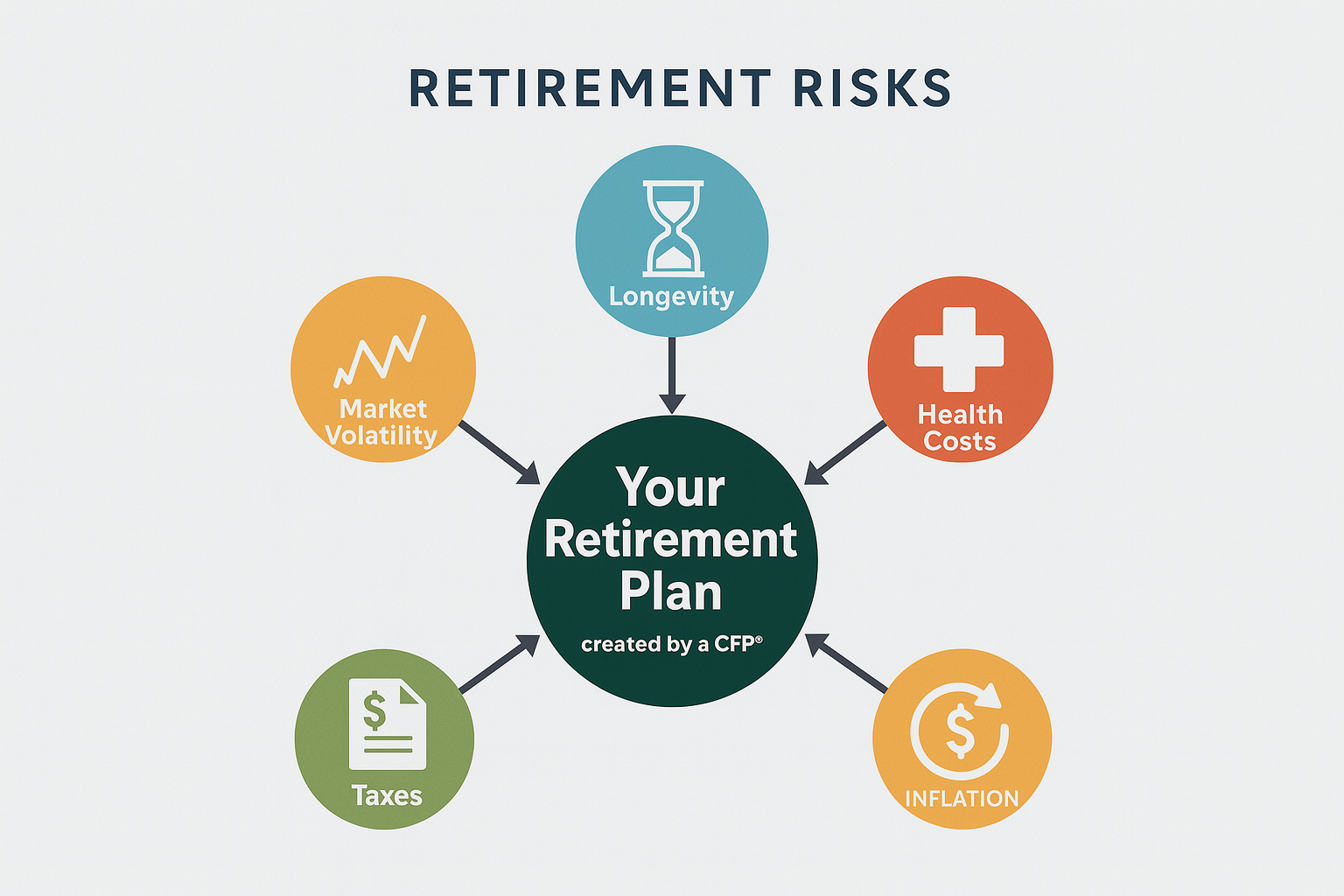What’s the Biggest Risk to Your Retirement Today?
Retirement isn’t compromised by what you expect, it’s the hidden and overlooked risks that matter most.
Retirement is supposed to be the payoff after decades of hard work — time for freedom, travel, family, and peace of mind. Yet ask ten retirees what keeps them up at night, and you’ll likely hear ten different answers.
Some worry about the stock market. Others about taxes. Many quietly wonder if they’ll live long enough to spend the money they’ve saved.
But here’s the truth: the biggest risk isn’t always what you expect. And the danger is not having a plan that’s ready for it.
The Stock Market Gets the Headlines, But It’s Not the Whole Story
The stock market’s ups and downs dominate financial news.
And yes, a sudden downturn can be particularly painful, especially in your early retirement years when you’re starting to draw from your investment portfolio. This risk is defined as “sequence of returns” risk.
This risk is very real and needs to be protected against, but the market is only one piece of the puzzle.
It’s also important not to be too reactionary as an investor. Those who panic and sell at the wrong time, locking in losses, often miss the recovery that follows and end up hurting their long-term results far more than the downturn itself.
A portfolio tailored to your spending needs, with enough cash and conservative investments set aside, helps you ride out market downturns.
Just look at the S&P 500 (as an example) over the last 40 years.. Yes, there are some dips along the way, but the further out we get, the smaller they become. The market has remained remarkably resilient over time.
Source: Yahoo Finance
Longevity: A Blessing and a Curveball
We don’t like to think of living longer as a risk, but financially, it can be.
Retiring at 65 and living to 95 means your money needs to last at least 30 years.
Many retirees underestimate how long they may live, which can leave them financially vulnerable in their later years.
But with medical advances, it will not be unusual to see retirees today living well into their 90s or even past 100.
Running out of money too early isn’t just a math problem; it’s a lifestyle problem.
The best way to prepare is by stress-testing your retirement plan against longer life expectancies. That means looking at whether your retirement savings, pensions, and Social Security benefits can support you well into your 90s or beyond.
Health Care Costs: The Silent Budget-Buster
Ask most retirees how much they’ll spend on health care, and the estimates are far too low.
Medicare helps, but it doesn’t cover everything, most notably, long-term care.
A couple retiring today at 65 may need hundreds of thousands of dollars over the course of their retirement for medical expenses.
Add in skilled nursing at $100,000/yr.+ and you can see how quickly medical costs can get away from a retiree.
Medical Spend is a HUGE driver of overall price increases for retirees over the last 30 years
The key is building in contingency funds or insurance strategies, so health costs don’t derail the rest of your retirement lifestyle.
This can include:
Keeping a dedicated cash reserve for unexpected medical bills.
Evaluating long-term care insurance or hybrid life/long-term care policies.
Using tax-advantaged accounts like Health Savings Accounts (HSAs) when available.
Some retirees may also want to earmark part of their portfolio for medical expenses.
By separating these costs from your everyday spending, you reduce the risk that an illness or prolonged care need will force you to cut back on travel, hobbies, or family experiences.
The Risk Nobody Talks About: Playing It Too Safe
Here’s an overlooked truth: some retirees never enjoy the money they worked so hard to save.
They retire with a healthy sum of money, but fear of the unknown makes them freeze.
Instead of enjoying the freedom they planned for, they quietly deny themselves the experiences, travel, and generosity they once dreamed about.
This “underspending trap” is often driven by the same fear that pushes others to overspend: the fear of running out. Only in this case, the result is a retirement that feels smaller, more restricted, and less joyful than it could be.
The antidote is having a plan that shows you what’s sustainable.
One effective approach is using retirement spending guardrails. These give you a clear range for how much you can safely withdraw each year, adjusting up or down depending on how markets perform.
If investments do well, you have the green light to enjoy more. If markets stumble, the guardrails help you dial back spending slightly to protect long-term sustainability.
Take the below retiree as an example. They have amassed a portfolio of roughly $2 million.
They know their plan currently supports $13,500 a month in spending. If their portfolio grows to $2,174,000, that number can increase to $14,100. And if a major market downturn dropped their portfolio to $1,403,000, their spending would only need to adjust down to $12,900.
Source: IncomeLab - Retirement Income Software
This kind of framework replaces uncertainty with clarity, giving you the confidence to live fully today without compromising tomorrow.
So, What’s Really the Biggest Risk?
The truth is, there’s no single “biggest risk.”
The danger lies in not identifying the proper risks and not having an appropriate plan that addresses them.
The retirees who thrive aren’t the ones who avoided every risk.
They’re the ones who designed their plan with flexibility, allowing them to adjust when markets move, health needs arise, or unexpected events occur.








